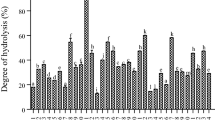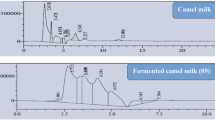Abstract
Fermented milk has been shown to have beneficial effects on human health exerted through its bioactive peptides. The lactose-fermenting brown rot fungus Neolentinus lepideus has been shown to ferment milk; however, its ability to produce bioactive peptides has not been explored. This study, therefore, aimed to investigate the ability N. lepideus for the production of antihypertensive peptides in fermented milk and to characterize the peptides. Here we have used 9% skim milk as the substrate and fermented it with the mycelia of N. lepideus. The fermented milk exhibited higher angiotensin I-converting enzyme (ACE) inhibitory activity as compared to the commercially available sour milk containing Ile-Pro-Pro and Val-Pro-Pro. As a result of isolation and purification by reverse-phase high-performance liquid chromatography, followed by peptide sequencing and MS analysis, the dipeptide Tyr-Pro (YP) was identified as an active peptide. The concentration of YP in the fermented milk reached up to 450 μg/ml, which was > twofold higher than the IC50 for ACE inhibition. Subsequently, the antihypertensive effect of YP was validated through intravenous injection of the peptide, which exhibited a significant lowering of blood pressure in a rat model of genetic hypertension. In addition, the transcriptomic analysis revealed the probable role of the carboxypeptidases for the increased yield of YP. These results together indicated that the fermentation with basidiomycete fungus could be a viable approach to produce bioactive peptides, and may, therefore, be applicable in the development of a cost-effective mass production system for functional peptides.







Similar content being viewed by others
Abbreviations
- ACE:
-
Angiotensin I-converting enzyme
- RP-HPLC:
-
Reverse-phase high-performance liquid chromatography
- HPLC:
-
High-performance liquid chromatography
- ESI–MS:
-
Electrospray ionization mass spectrometry
- YP:
-
Dipeptide Tyr-Pro
- RAAS:
-
Renin-angiotensin aldosterone system
- TFA:
-
Trifluoroacetic acid
- IPP:
-
Ile-Pro-Pro
- VPP:
-
Val-Pro-Pro
- FPKM:
-
Fragments per kilobase of transcript per million mapped reads
- SHR:
-
Spontaneously hypertensive rat
- SHRSP:
-
Stroke-prone spontaneously hypertensive rat
- MAP:
-
Mean arterial pressure
References
De la Sierra A (2019) New American and European hypertension guidelines, reconciling the differences. Cardiol Ther 8:157–166
Qiu C, Winblad B, Fratiglioni L (2005) The age-dependent relation of blood pressure to cognitive function and dementia. Lancet Neurol 4:487–499
World Health Organization (2013) A global brief on HYPERTENSION—silent killer, global public health crisis, Geneva, World Health Organization. https://ish-world.com/downloads/pdf/global_brief_hypertension.pdf
Laragh JH, Baer L, Brunner HR, Buhler FR, Sealey JE, Vaughan ED Jr (1972) Renin, angiotensin and aldosterone system in pathogenesis and management of hypertensive vascular disease. Am J Med 52:633–652
Atlas SA (2007) The renin–angiotensin aldosterone system: pathophysiological role and pharmacologic inhibition. J Manag Care Pharm 13:9–20
Atkinson AB, Robertson JI (1979) Captopril in the treatment of clinical hypertension and cardiac failure. Lancet 2:836–839
Brown NJ, Vaughan DE (1998) Angiotensin-converting enzyme inhibitors. Circulation 97:1411–1420
Angelo A, Marco C (2001) Drug-induced angioedema without urticaria. Drug Saf 24:599–606
Chen J, Wang Y, Ye R, Wu Y, Xia W (2013) Comparison of analytical methods to assay inhibitors of angiotensin I-converting enzyme. Food Chem 141:3329–3334
Hieda K, Sunagawa Y, Katanasaka Y, Hasegawa K, Morimoto T (2015) Antihypertensive effects of foods. World J Hypertens 5:53–62
Iwaniak A, Minkiewicz P, Darewicz M (2014) Food-originating ACE inhibitors, including antihypertensive peptides, as preventive food components in blood pressure reduction. Compr Rev Food Sci Food Saf 13:114–134
Korhonen H, Pihlanto A (2006) Bioactive peptides: production and functionality. Int Dairy J 16:945–960
Yokoyama K, Chiba H, Yoshikawa M (1992) Peptide inhibitors for angiotensin I-converting enzyme from thermolysin digest of dried bonito. Biosci Biotechnol Biochem 56:1541–1545
Matsui T, Matsufuji H, Seki E, Osajima K, Nakashima M, Osajima Y (1993) Inhibition of angiotensin I-converting enzyme by Bacillus licheniformis alkaline protease hydrolyzates derived from sardine muscle. Biosci Biotechnol Biochem 57:922–925
Nakamura Y, Yamamoto N, Sakai K, Okubo A, Yamazaki S, Takano T (1995) Purification and characterization of angiotensin I-converting enzyme inhibitors from sour milk. J Dairy Sci 78:777–783
Nakamura Y, Yamamoto N, Sakai K, Takano T (1995) Antihypertensive effect of sour milk and peptides isolated from it that are inhibitors to angiotensin I-converting enzyme. J Dairy Sci 78:1253–1257
Nakamura Y, Masuda O, Takano T (1996) Decrease of tissue angiotensin I-converting enzyme activity upon feeding sour milk in spontaneously hypertensive rats. Biosci Biotechnol Biochem 60:488–489
Hata Y, Yamamoto N, Ohni M, Nakajima K, Nakamura Y, Takano T (1996) A placebo-controlled study of the effect of sour milk on blood pressure in hypertensive subjects. Am J Clin Nutr 64:767–771
Yamamoto N, Maeno M, Takano T (1999) Purification and characterization of antihypertensive peptide from a yogurt-like product fermented by Lactobacillus helveticus CPN4. J Dairy Sci 82:1388–1393
Pan D, Luo Y, Tanokura M (2005) Antihypertensive peptides from skimmed milk hydrolysate digested by cell-free extract of Lactobacillus helveticus JCM1004. Food Chem 91:123–129
Fitzgerald RJ, Murray BA (2006) Bioactive peptides and lactic fermentations. Int J Dairy Technol 59:118–125
Beltrán-Barrientos LM, Hernández-Mendoza A, Torres-Llanez MJ, González-Córdova AF, Vallejo-Córdoba B (2016) Fermented milk as antihypertensive functional food. J Dairy Sci 99:4099–4110
Raveschot C, Cudennec B, Coutte F, Flahaut C, Fremont M, Drider D, Dhulster P (2018) Production of bioactive peptides by Lactobacillus species: from gene to application. Front Microbiol 9:2354
Quist EE, Phillips RD, Saalia FK (2009) Angiotensin converting enzyme inhibitory activity of proteolytic digests of peanut (Arachis hypogaea L.) flour. LWT Food Sci Technol 42:694–699
Rho SJ, Lee JS, Chung YI, Kim YW, Lee HG (2009) Purification and identification of an angiotensin I-converting enzyme inhibitory peptide from fermented soybean extract. Process Biochem 44:490–493
Balti R, Bougatef A, Sila A, Guillochon D, Dhulster P, Nedjar-Arroume N (2015) Nine novel angiotensin I-converting enzyme (ACE) inhibitory peptides from cuttlefish (Sepia officinalis) muscle protein hydrolysates and antihypertensive effect of the potent active peptide in spontaneously hypertensive rats. Food Chem 170:519–525
Xue L, Wang X, Hu Z, Wu Z, Wang L, Wang H, Yang M (2018) Identification and characterization of an angiotensin-converting enzyme inhibitory peptide derived from bovine casein. Peptides 99:161–168
Okamoto K, Nakagawa S, Kanawaku R, Kawamura S (2019) Ethanol production from cheese whey and expired milk by the brown rot fungus Neolentinus lepideus. Fermentation 5:49
Mathai JK, Liu Y, Stein HH (2017) Values for digestible indispensable amino acid scores (DIAAS) for some dairy and plant proteins may better describe protein quality than values calculated using the concept for protein digestibility-corrected amino acid scores (PDCAAS). Br J Nutr 117:490–499
Cushman DW, Cheung HS (1970) Spectrophotometric assay and properties of the angiotensin-converting enzyme of rabbit lung. Biochem Pharmacol 20:1637–1648
Rahimi MH, Shab-Bidar S, Mollahosseini M, Djafarian K (2017) Branched-chain amino acid supplementation and exercise-induced muscle damage in exercise recovery: a meta-analysis of randomized clinical trials. Nutrition 42:30–36
Saito Y, Wanezaki K, Kawato A, Imayasu S (1994) Structure and activity of angiotensin I converting enzyme inhibitory peptides from sake and sake lees. Biosci Biotechnol Biochem 58:1767–1771
Jarmołowska B, Kostyra E, Krawczuk S, Kostyra H (1999) β-Casomorphin-7 isolated from Brie cheese. J Sci Food Agric 79:1788–1792
Singh TK, Fox PF, Healy A (1997) Isolation and identification of further peptides in the diafiltration retentate of the water-soluble fraction of Cheddar cheese. J Dairy Res 64:433–443
Saito T, Nakamura T, Kitazawa H, Kawai Y, Itoh T (2000) Isolation and structural analysis of antihypertensive peptides, that exist naturally in Gouda cheese. J Dairy Sci 83:1434–1440
Pihlanto-Leppälä A, Rokka T, Korhonen H (1998) Angiotensin I converting enzyme inhibitory peptides derived from bovine milk proteins. Int Dairy J 8:325–331
Abubakar A, Saito T, Kitazawa H, Kawai Y, Itoh T (1998) Structural analysis of new antihypertensive peptides derived from cheese whey protein by proteinase K digestion. J Dairy Sci 81:3131–3138
Meisei H (1998) Overview on milk protein-derived peptides. Int Dairy J 8:363–373
den Hengst CD, Curley P, Larsen R, Buist G, Nauta A, van Sinderen D, Kuipers OP, Kok J (2005) Probing direct interactions between CodY and the oppD promoter of Lactococcus lactis. J Bacteriol 187:512–521
Wakai T, Yamamoto N (2013) A novel branched chain amino acids responsive transcriptional regulator, BCARR, negatively acts on the proteolytic system in Lactobacillus helveticus. PLoS ONE 8:e75976
Cheung HS, Wang FL, Ondetti MA, Sabo EF, Cushman DW (1980) Binding of peptide substrates and inhibitors of angiotensin-converting enzyme. J Biol Chem 255:401–407
Cheung LKY, Aluko RE, Cliff MA, Li-Chan ECY (2015) Effects of exopeptidase treatment on antihypertensive activity and taste attributes of enzymatic whey protein hydrolysates. J Funct Foods 13:262–275
Ueno K, Mizuno S, Yamamoto N (2004) Purification and characterization of an endopeptidase that has an important role in the carboxyl terminal processing of antihypertensive peptides in Lactobacillus helveticus CM4. Lett Appl Microbiol 39:313–318
Wakai T, Yamaguchi N, Hatanaka M, Nakamura Y, Yamamoto N (2012) Repressive processing of antihypertensive peptides, Val-Pro-Pro and Ile-Pro-Pro, in Lactobacillus helveticus fermented milk by added peptides. J Biosci Bioeng 114:133–137
Wakai T, Shinoda T, Uchida N, Hattori M, Nakamura Y, Beresford T, Ross RP, Yamamoto N (2013) Comparative analysis of proteolytic enzymes need for processing of antihypertensive peptides between Lactobacillus helveticus CM4 and DPC4571. J Biosci Bioeng 115:246–252
Acknowledgements
This work was supported by the Project of the NARO Bio-oriented Technology Research Advancement Institution (Research program on development of innovative technology) [Grant number 28010A]. We would like to thank Editage (https://www.editage.jp) for English language editing.
Author information
Authors and Affiliations
Contributions
KO conceptualized and designed the study, performed the experiments, drafted the initial manuscript, reviewed the manuscript, and revised the manuscript. SK and MT performed the experiments and analyzed the data. TM contributed to the amino acid analysis, peptide sequencing, and MS analysis. HMZ performed the animal experiments. TN designed animal experiments and reviewed the manuscript. All authors approved the final manuscript as submitted and agree to be accountable for all aspects of the work.
Corresponding author
Ethics declarations
Conflict of interest
The authors declare no conflict of interest.
Compliance with ethics requirements
The procedures of animal experiments were reviewed and approved by the local committee for animal research at Shimane University. The animal experiments were performed in accordance with relevant guidelines and regulations.
Additional information
Publisher's Note
Springer Nature remains neutral with regard to jurisdictional claims in published maps and institutional affiliations.
Rights and permissions
About this article
Cite this article
Okamoto, K., Kawamura, S., Tagawa, M. et al. Production of an antihypertensive peptide from milk by the brown rot fungus Neolentinus lepideus. Eur Food Res Technol 246, 1773–1782 (2020). https://doi.org/10.1007/s00217-020-03530-y
Received:
Revised:
Accepted:
Published:
Issue Date:
DOI: https://doi.org/10.1007/s00217-020-03530-y




